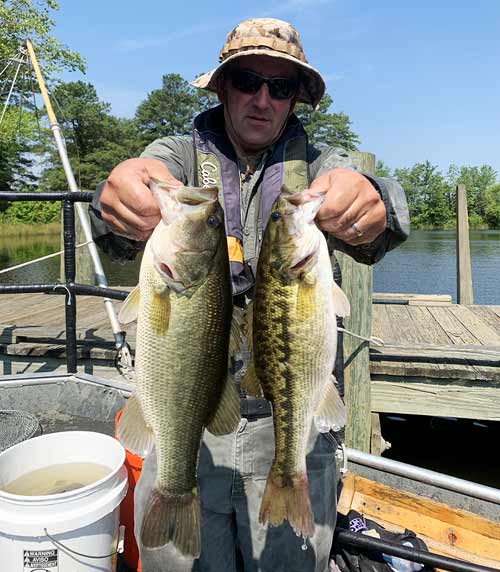
Alabama Bass, Micropterus henshalli, are a real threat to Virginia’s established largemouth and smallmouth bass fisheries. This invasive species has been illegally introduced into the Commonwealth, and we are currently in the early stages of the invasion. Alabama bass, a native to Georgia and Alabama, have been shown to outcompete largemouth bass and hybridize with smallmouth bass—posing a great threat to Virginia’s renowned bass fisheries.
New Virginia Department of Wildlife Resources (DWR) regulations are currently in effect to halt the spread of Alabama bass. Alabama bass have been added to Virginia’s Predatory and Undesirable Species List, making live possession unlawful outside of the body of water of catch. Violations of this regulation are a class III misdemeanor. There is no bag or size limit on Alabama bass, and anglers are encouraged to harvest any that they capture. Anglers are reminded that it is illegal to stock fish into a public body of water without an authorization from DWR. Anyone with knowledge of intentional stockings of Alabama or Spotted Bass should contact DWR law enforcement at 800-237-5712 or WildCrime@dwr.virginia.gov.
DWR biologists are closely monitoring the spread of Alabama bass through extensive sampling and genetic analysis. However, DWR is not alone in the fight to prevent the spread of this invasive species. DWR has partnered with the Virginia Chapter of The Bass Federation (TBF), the Bass Anglers Sportsman Society (BASS), and the Bass Fishing Hall of Fame in an effort to spread awareness about the threat Alabama bass pose. The partnership is essential in the effort to prevent the spread of this species across Virginia.
A recent grant from the Bass Fishing Hall of Fame played an integral role in the partnership’s development of an informational brochure that is a call to action for anglers in Virginia. The brochure contains information about Alabama bass, identification, and what to do if you suspect you have caught this invasive species.
“We are extremely pleased with the opportunity to partner with the Virginia Department of Wildlife Resources and our fellow bass fishing organizations on the Alabama Bass Invasive Species Identification and Containment effort,” said John Flicek, Conservation Director for the Virginia Chapter of TBF. “The brochures and sampling kits developed through this project are essential in educating not only tournament anglers but the general public on the consequences of illegal stockings of non-native species. The Federation is a community of anglers that specifically target bass on nearly every body of water throughout the state. Tournament anglers will generally cover an entire body of water and tournament catches will provide supplemental information on presence or absence of Alabama bass. We believe that the data collected during tournament activities will aid greatly in determining the extent of the Alabama Bass migration through Virginia waters.”
Gene Gilliland, BASS National Conservation Director, added that, “More and more we hear about anglers moving fish in hopes it will make their fishing better. Unfortunately in almost every case, unintended consequences catch up with them and the results are far worse than what they started with. Cooperative efforts to educate the angling public about the problem are the solution. Projects like this that utilize the resources and reach of organizations like the Bass Fishing Hall of Fame, TBF and the B.A.S.S. Nation, working in conjunction with the state fisheries management agency, are what is needed to spread the message.”
Virginia BASS Conservation Director, Joan Blankenship, agreed. “The movement of bass from one lake to another is a good example of perceiving that it is a good idea without doing any homework. Although the fish are already taking over Virginia lakes, anglers have asked more questions about Alabama bass movement than any other in a long time. This is really encouraging,” she said.
“We can’t stop the spread of this species without the help of our anglers,” said Mike Bednarski, Chief of Fisheries at Virginia DWR. “As a bass angler myself, I have seen firsthand how the bass fishing community has supported fisheries conservation, advocating for catch and release, habitat improvement, fish care, and responsible resource use. Further conservation efforts, joined by this partnership, will stop the spread of Alabama bass and help preserve Virginia’s largemouth and smallmouth fisheries into the future.”
DWR, TBF, and BASS are actively distributing the information brochures to anglers fishing across the state. In addition to these brochures, anglers might also recognize the Know the Difference poster at boat ramps and tackle shops across the state. This poster shows key features to successfully identify Alabama bass versus largemouth bass. If anglers suspect that they have caught an Alabama bass, they should clip a thumbnail size portion of the pelvic fin and store dry in an envelope before emailing a photo of the fish and information on where it was caught to fisheries@dwr.virginia.gov. DWR will then contact the angler for additional information and the fin clip if necessary.
Now is the time for anglers to step up and aid DWR and the partnership’s efforts to monitor and prevent the spread of this invasive species. We are truly blessed with incredible largemouth and smallmouth bass fisheries in Virginia. These are fisheries that benefit the economy in addition to bringing anglers and family members closer through shared time on the water. It’s imperative that we protect the integrity of these fisheries for generations to come.
For additional information on Alabama bass and identification visit the Alabama bass page on the DWR website.
